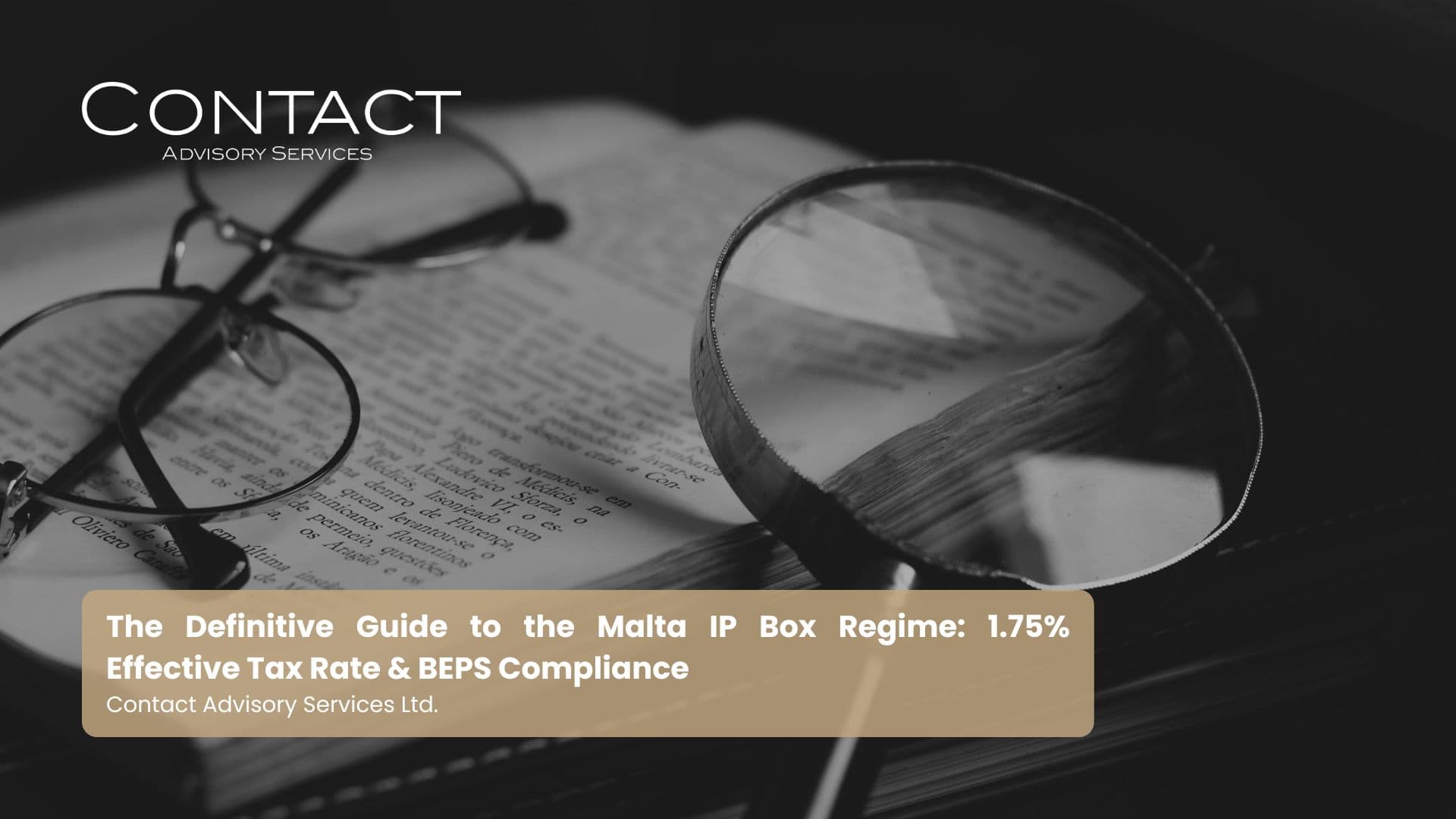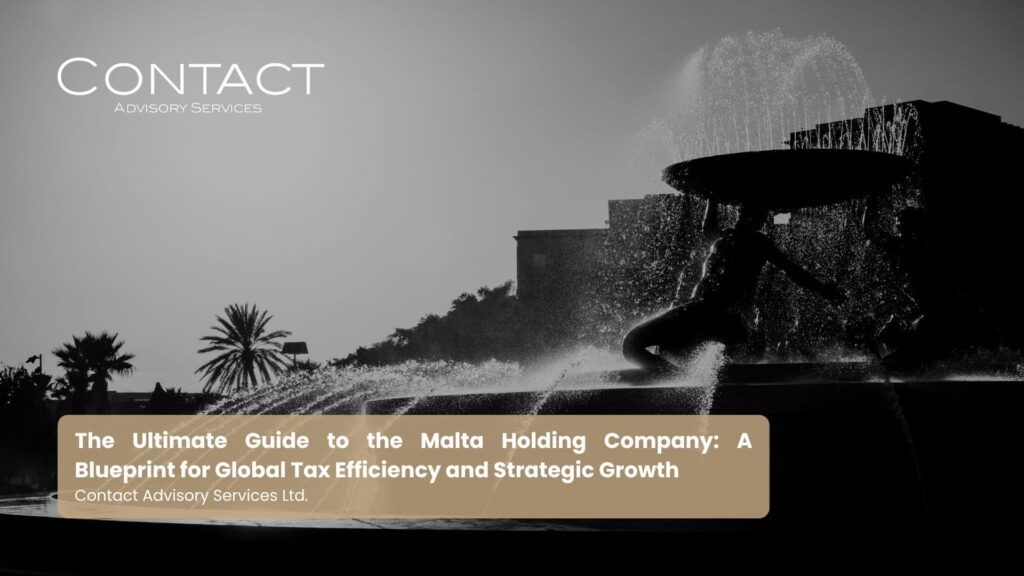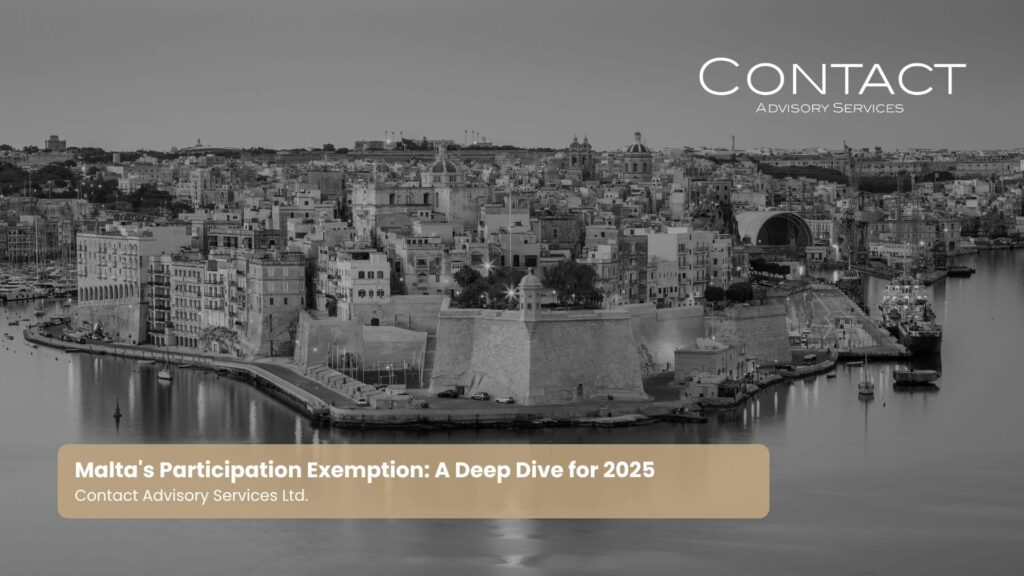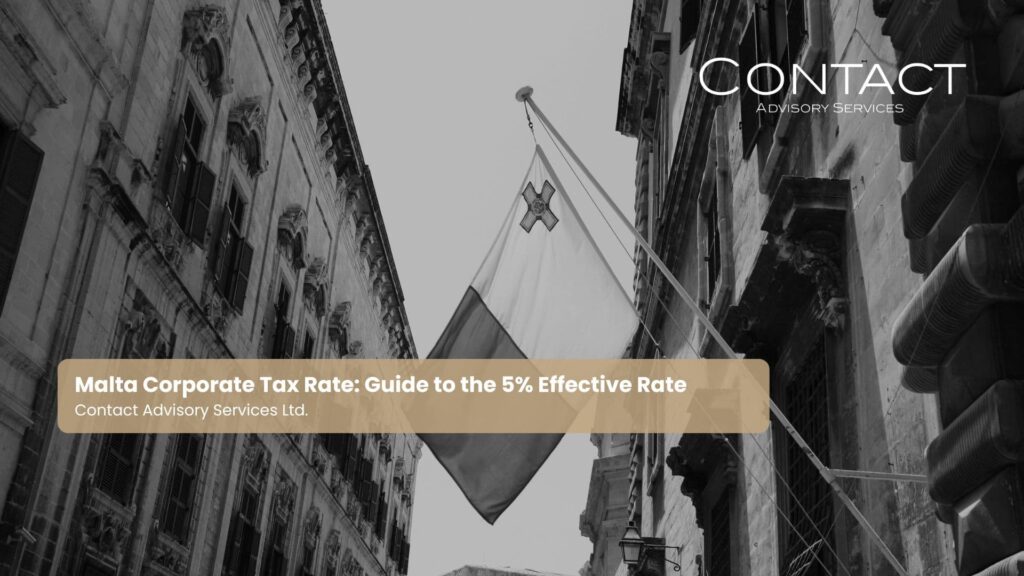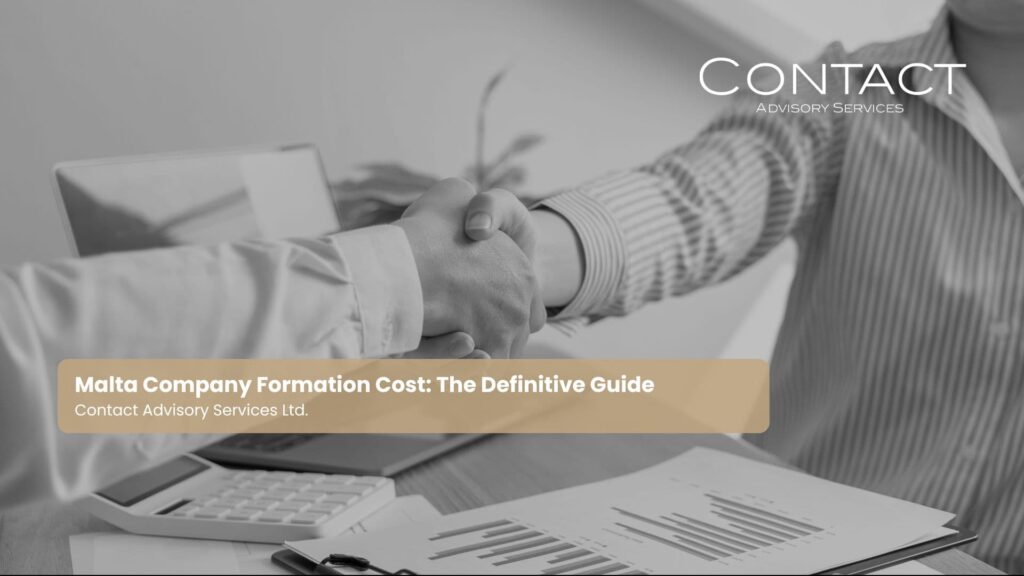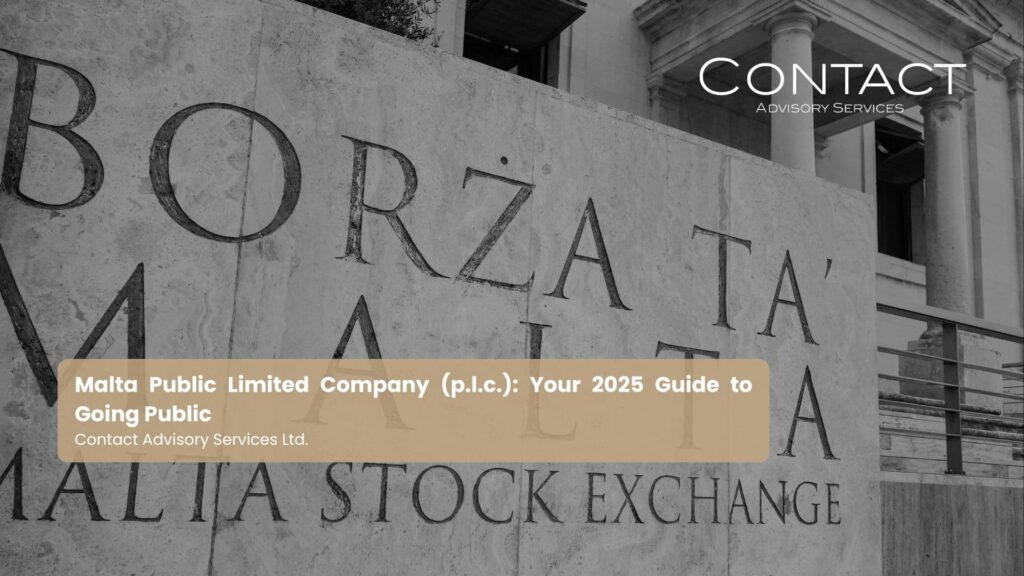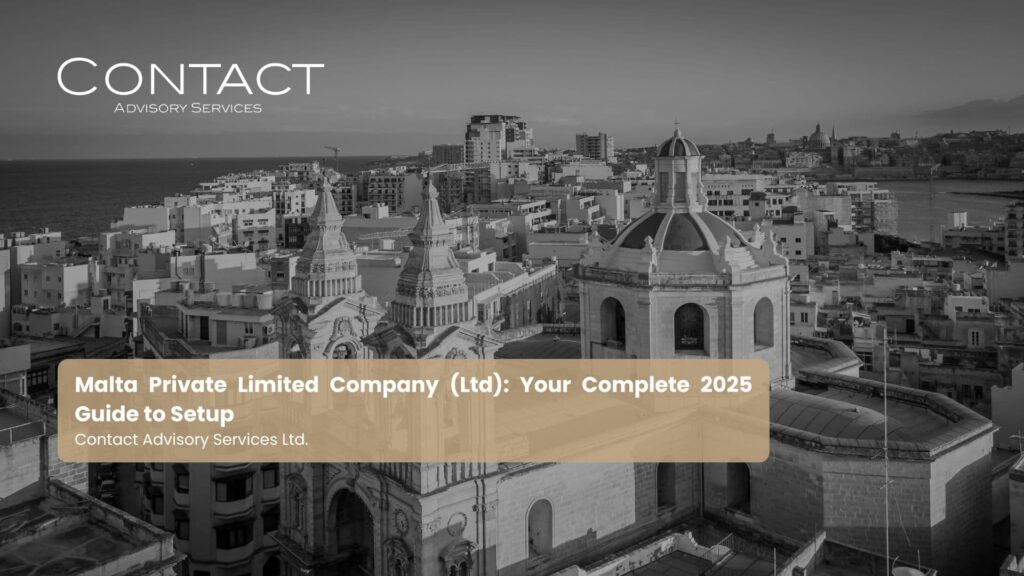In today’s global economy, innovation is the primary driver of value. For companies in sectors like technology, pharmaceuticals, and iGaming, intellectual property (IP) isn’t just an asset; it’s the core of the business. However, monetizing this IP efficiently is a significant challenge, with high corporate tax rates and complex international compliance standards like the OECD’s Base Erosion and Profit Shifting (BEPS) framework eroding profitability. How can a company leverage its valuable patents, copyrights, and software while remaining compliant and tax-efficient?
This guide provides the definitive answer. We will explore the Malta Patent Box Regime, a sophisticated, EU-approved, and BEPS-compliant framework that allows qualifying companies to achieve a headline-grabbing effective corporate tax rate as low as 1.75% on income derived from their intellectual property.
As an MFSA Authorised Company Services Provider, Contact Advisory Services Ltd. has extensive experience guiding technology and R&D-focused companies through the complexities of this regime. This guide will provide an expert, detailed breakdown of the entire framework. We will cover the 95% deduction mechanism, the crucial BEPS Modified Nexus Approach, what constitutes “Qualifying IP” (including the critical inclusion of software), and how to calculate the benefit using the Nexus Ratio.
What is the Core Advantage of the Malta Patent Box Regime?
The primary advantage is a significant tax reduction, allowing businesses to claim a 95% deduction on qualifying IP income. This deduction, when applied to Malta’s 35% corporate tax rate, results in a final, and globally competitive, effective tax rate of just 1.75%. This regime is designed to reward companies that conduct substantive R&D activities, aligning tax benefits directly with innovation.
How is the 1.75% Effective Tax Rate Achieved?
The 1.75% rate is the mathematical outcome of Malta’s tax rules applied to qualifying income. The regime allows a taxpayer to deduct 95% of their net qualifying IP income from their taxable income. The remaining 5% is then taxed at Malta’s standard corporate tax rate of 35%, which calculates to an effective rate of 1.75% (35% * 5% = 1.75%).
Let’s illustrate with a simple example:
- A Maltese company earns €1,000,000 in net royalties from a qualifying patent.
- Under the IP Box Regime, it can claim a 95% deduction on this income, which is €950,000.
- The company’s taxable income is now reduced to €50,000 (€1,000,000 – €950,000).
- This €50,000 is taxed at the standard 35% rate: €50,000 * 35% = €17,500.
- Therefore, the total tax paid on €1,000,000 of profit is €17,500. This represents an effective tax rate of 1.75%.
How Does Malta’s IP Box Compare to Other EU Jurisdictions?
Malta’s regime is one of the most attractive in the EU, not only for its low 1.75% effective rate but also for its broad definition of qualifying IP, which includes software. While other countries like Cyprus and the Netherlands offer their own patent boxes, Malta’s often provides a more advantageous and flexible framework, especially for tech and software companies.
Here is a high-level comparison of popular EU IP Box Regimes.
| Feature | Malta (IP Box Regime) | Cyprus (IP Box Regime) | Netherlands (Innovation Box) | Ireland (Knowledge Dev. Box) |
| Effective Tax Rate | 1.75% (lowest) | 2.5% | 9% | 6.25% |
| Qualifying Assets | Patents, software (copyright), utility models, plant varieties. | Patents, software (copyright), utility models. | Patents, R&D certificates (WBSO), software. | Patents, software (copyright), plant varieties. |
| Nexus Approach | Yes (OECD Modified Nexus) | Yes (OECD Modified Nexus) | Yes (Modified Nexus) | Yes (OECD Modified Nexus) |
| Exclusions | Trademarks, brands, goodwill, “marketing IP”. | Trademarks, brands, goodwill. | Trademarks, logos. | Trademarks, brands, goodwill. |
| Our Expert Take | Highly competitive rate with a crucial inclusion of software copyright, making it ideal for tech firms. | Also very competitive, but Malta’s 1.75% is lower. | Higher effective tax rate, but well-regarded. | A solid option, but the rate is higher than Malta’s. |
As the table shows, Malta’s combination of the lowest effective rate and a clear inclusion of copyrighted software gives it a significant competitive edge for modern digital businesses.
How Does the Malta Patent Box Ensure Legal & BEPS Compliance?
The regime is built upon the OECD BEPS Modified Nexus Approach, as mandated by Action 5 of the BEPS project. This approach is codified in Malta’s domestic law (S.L. 123.194), which ensures that tax benefits are only granted to companies that can demonstrate genuine substance and a direct link between the income, the R&D activities, and the expenditures incurred to develop the IP. It explicitly excludes passive IP holding companies.
What is the OECD BEPS Modified Nexus Approach?
The Modified Nexus Approach is the global standard for IP regimes, designed to combat tax avoidance. It establishes a mandatory, direct link (a “nexus”) between the qualifying income eligible for benefits, the R&D expenditure that contributed to that income, and the R&D activity (substance) performed by the taxpayer. In simple terms: no substance, no benefit.
This approach ensures that a company cannot simply buy an IP asset, move it to a low-tax jurisdiction like Malta, and enjoy tax benefits without performing the underlying development work. The tax benefit is proportional to the R&D expenditure incurred by the company itself (or outsourced to an unrelated third party). This is the core principle that makes the Maltese regime robust, transparent, and internationally accepted.
What are Malta’s Patent Box Regime (Deduction) Rules?
These are the specific domestic laws, found in Subsidiary Legislation 123.194, that transpose the OECD’s framework into Maltese law. These rules formally define “Qualifying IP,” outline the “Nexus Ratio” calculation, and detail the “substance test” requirements. They provide the legal and procedural certainty that businesses and tax authorities rely upon.
Key elements of these rules include:
- A clear definition of what constitutes Qualifying IP (see next section).
- The precise formula (the Nexus Ratio) for calculating the proportion of income eligible for the 95% deduction.
- Documentation and tracing requirements, obligating companies to track their R&D expenditure (QIPE and TIPE) per IP asset.
- Exclusion clauses for passive income and marketing-related IP.
As your corporate service provider, we navigate these specific rules to ensure your structure is fully compliant and that all documentation is meticulously maintained.
Are Passive IP Holding Companies Eligible?
No, they are not. The Malta Patent Box Regime is specifically designed to exclude passive holding structures. If a company’s sole activity is to hold IP assets and receive passive royalties without contributing to the development, management, or maintenance of that IP, it will not qualify for the benefits.
The regime targets active R&D and commercialization. A company must demonstrate:
- Active management: Strategic decisions regarding the IP are made in Malta.
- Substance: The company has the necessary physical presence, employees, and resources in Malta to perform the “Development, Enhancement, Maintenance, Protection, and Exploitation” (DEMPE) functions related to its IP.
- Incurred expenditure: The company has directly funded the R&D that created the IP.
This focus on substance is non-negotiable and is a cornerstone of the regime’s legitimacy.
What Assets Qualify for the Malta Patent Box?
The Maltese regime has a broad and modern definition of “Qualifying IP,” which is a significant advantage. It includes traditional IP like patents and utility models, but most importantly, it also explicitly includes software protected by copyright. It specifically excludes “marketing IP” like trademarks and brands.
Is Software Protected by Copyright Considered Qualifying IP?
Yes, absolutely. This is one of the most powerful features of the Maltese regime and a key differentiator from more restrictive “patent-only” boxes in other countries. Software that is protected by copyright under Maltese or international law is explicitly listed as “Qualifying IP.”
This means that technology companies, SaaS providers, mobile app developers, and FinTech platforms can all potentially benefit from the 1.75% effective tax rate on the income generated from their proprietary code. This income can include:
- Software licensing fees.
- Subscription revenue (e.g., SaaS models).
- Income from in-app purchases or platform fees directly attributable to the copyrighted software.
To qualify, the software must be the result of a substantive R&D project and must not be “marketing software” (e.g., software that primarily markets a product or service).
What Other Types of IP are Included?
Beyond software, the rules cover a range of IP assets that result from formal research and development. This broad scope ensures that innovation across various scientific and technological fields is rewarded.
The full list of Qualifying IP includes:
- Patents or patents pending (issued or applied for).
- Utility Models.
- Software protected by copyright.
- Plant and genetic material and plant variety rights.
- Orphan drug designations.
- Other IP assets that are non-obvious, useful, and novel (this may require a specific ruling from Malta Enterprise, the government agency responsible).
What Assets are Explicitly Excluded?
The regime is designed to reward technological innovation, not marketing reach. Therefore, all “marketing-related IP” is explicitly excluded from the benefits. Managing client expectations on this point is crucial.
The list of excluded assets includes:
- Trademarks (e.g., brand names, logos, slogans).
- Service marks.
- Brand names.
- Goodwill.
- Trade secrets and “know-how” (unless they are intrinsically linked to a primary qualifying asset like a patent).
- Customer lists and databases.
- Image rights and other marketing-related intangibles.
If a company earns “mixed income” (e.g., a software license fee that also includes a fee for using a brand name), the income must be bifurcated, with only the portion attributable to the qualifying software being eligible for the deduction.
How is the 1.75% Effective Tax Rate Calculated?
The 1.75% rate is not automatic; it is the maximum benefit achieved when the “Nexus Ratio” is 100%. This ratio is a formula mandated by the OECD that links the income receiving benefits to the R&D expenditure that created it. The formula is: (Qualifying IP Expenditure / Total IP Expenditure) * Total IP Income.
What is the Nexus Ratio Formula?
The Nexus Ratio is the heart of the BEPS compliance mechanism. It determines what proportion of your IP income is eligible for the 95% deduction. The final deduction is calculated using this formula:
Deduction = (Qualifying IP Income) * (Nexus Ratio) * 95%
Where the Nexus Ratio is defined as:
Nexus Ratio = Qualifying IP Expenditure (QIPE) / Total IP Expenditure (TIPE)
- This ratio cannot exceed 100% (or 1).
- If your QIPE is €80,000 and your TIPE is €100,000, your Nexus Ratio is 80%.
- This means only 80% of your IP income qualifies for the 95% deduction.
What is “Qualifying IP Expenditure” (QIPE)?
QIPE (the numerator) represents the “good” R&D costs that demonstrate substance. It includes R&D costs incurred directly by the Maltese company or outsourced to unrelated third parties. It also includes a special “uplift” provision to account for acquisition costs and related-party outsourcing.
Specifically, QIPE includes:
- Direct R&D Costs: Salaries, materials, and other costs directly related to the R&D activities performed by the company’s own employees in Malta.
- Unrelated Subcontracting: Costs of R&D activities outsourced to any third party that is not a related entity.
- The “Uplift”: The rules allow for a 30% “uplift” on the above costs, which can help offset “bad” costs (TIPE). This uplift is capped at the total amount of TIPE.
What is “Total IP Expenditure” (TIPE)?
TIPE (the denominator) represents the total cost incurred to develop the IP asset. It includes all the “good” costs from QIPE, plus the “bad” costs that do not demonstrate substance in Malta.
TIPE includes:
- All costs included in QIPE.
- IP Acquisition Costs: The cost of buying the IP asset from another party (related or unrelated).
- Related-Party Subcontracting: Costs of R&D activities outsourced to related or connected entities.
The logic is simple: if a company just buys an patent (high TIPE) and performs no R&D itself (low QIPE), its Nexus Ratio will be very low, and it will receive little to no tax benefit. This is the BEPS framework in action.
Can You Provide a Worked Example of the Calculation?
Yes. A worked example clearly demonstrates how these components interact to determine the final tax bill. Let’s assume a Maltese tech company, “TechServe Ltd.,” develops a new software platform.
Assumptions:
- Qualifying IP Income (from software licenses): €1,000,000
- Direct R&D Costs (local developer salaries): €150,000
- Unrelated Subcontracting (hired a specialist UK firm): €50,000
- Related-Party Subcontracting (used a sister company for QA): €30,000
- IP Acquisition Costs (bought a small code library): €20,000
Step 1: Calculate QIPE (Good Costs)
- QIPE = (Direct R&D + Unrelated Subcontracting) + 30% Uplift
- QIPE = (€150,000 + €50,000) = €200,000
- Uplift Calculation: 30% of €200,000 = €60,000.
- Uplift Cap: Total “bad costs” = €30,000 + €20,000 = €50,000.
- Applied Uplift: The uplift is capped at the lower of the 30% (€60k) or the total bad costs (€50k). So, we can add €50,000.
- Final QIPE = €200,000 + €50,000 = €250,000
Step 2: Calculate TIPE (Total Costs)
- TIPE = (Direct R&D + Unrelated Subcontracting) + (Related Subcontracting + Acquisition)
- TIPE = (€150,000 + €50,000) + (€30,000 + €20,000)
- Final TIPE = €250,000
Step 3: Calculate the Nexus Ratio
- Nexus Ratio = QIPE / TIPE
- Nexus Ratio = €250,000 / €250,000 = 100% (or 1)
- Result: Because the company’s “good” costs, amplified by the uplift, equalled its total costs, it is entitled to the full benefit.
Step 4: Calculate the Final Tax
- Eligible Income = Total IP Income * Nexus Ratio = €1,000,000 * 100% = €1,000,000
- Deduction = Eligible Income * 95% = €1,000,000 * 95% = €950,000
- Taxable Income = Total IP Income – Deduction = €1,000,000 – €950,000 = €50,000
- Final Tax Payable = Taxable Income * 35% = €50,000 * 35% = €17,500
- Effective Tax Rate = €17,500 / €1,000,000 = 1.75%
What Other Tax Benefits Work with the IP Box?
The IP Box Regime does not exist in a vacuum; it is amplified by Malta’s broader pro-business tax system. Key benefits include a full imputation system, a comprehensive corporate tax refund system for other income, and a 0% withholding tax on dividends, interest, and royalties paid to non-residents, making it exceptionally efficient for international structures.
How Does Malta’s Full Imputation System Benefit Shareholders?
Malta’s full imputation system completely eliminates the “double taxation” of company profits and shareholder dividends. When a Maltese company pays a dividend, it passes a “tax credit” to the shareholder equal to the 35% tax paid by the company. The shareholder is then taxed on the “grossed-up” dividend but can use this credit to offset their own tax liability, resulting in no further tax being due in Malta.
What is the Maltese Corporate Tax Refund System?
While the 1.75% IP Box rate is highly attractive, what about other income? For any “active” trading income that does not qualify for the IP Box, shareholders can claim a 6/7ths refund on the 35% tax paid by the company. This results in a final effective tax rate of just 5% on active trade income.
This provides a powerful “safety net.” If some of your income doesn’t meet the strict Nexus test, it doesn’t default to 35%; it defaults to a 5% effective rate, which is still one of the lowest in the EU.
Are There Withholding Taxes on Dividends from an IP Holding Company?
No. This is a critical component for international structuring. Malta does not levy any withholding tax (WHT) on outbound dividends paid to non-resident shareholders (whether corporate or individual).
Furthermore, thanks to Malta’s implementation of the EU Interest & Royalties Directive and its extensive double-tax treaty network, WHT on outbound interest and royalty payments can also be reduced to 0%. This ensures that profits generated from your IP can be repatriated to your parent company or ultimate beneficial owners with maximum efficiency.
How Can You Set Up a Maltese Company for the IP Box Regime?
Setting up a company for the IP Box requires a structured approach to ensure both legal incorporation and tax compliance. The process involves engaging an authorised provider like us, incorporating the company, establishing local substance, and applying for a formal determination or ruling from Malta’s tax authorities to confirm the IP’s qualifying status and the calculation methodology.
Here is the typical step-by-step process we guide our clients through:
- Initial Consultation & Feasibility: We first analyse your business, your IP portfolio, and your R&D expenditure to confirm your eligibility for the regime.
- Corporate Structuring: We design the optimal corporate structure, which may involve a new dedicated Maltese IP company.
- Company Incorporation: The foundational step is a robust Malta company formation, which establishes the legal entity to hold and manage the IP.
- Establishing Substance: We assist in setting up a physical office, hiring qualified local staff (e.g., developers, IP managers), and appointing local directors to meet the BEPS substance requirements.
- IP Transfer or Development: We assist with the legal transfer of existing IP to the Maltese company (at arm’s length) or advise on the correct procedures for developing new IP within the company.
- Tax Ruling Application: We prepare and submit a detailed application to the Maltese Commissioner for Revenue (CfR) and/or Malta Enterprise. This application outlines the business, the IP, the R&D expenditure, and the proposed Nexus Ratio calculation, seeking a formal, binding ruling.
- Annual Compliance: Once operational, we manage all ongoing compliance, including accounting, tax returns (which declare the IP Box deduction), and maintaining the necessary records to support the Nexus Ratio calculation.
Frequently Asked Questions (FAQ) about the Malta Patent Box
Can I transfer existing IP to a Maltese company?
Yes, you can. Existing IP can be transferred to a Maltese company, but it must be done at a fair market “arm’s length” price. This acquisition cost will be factored into the TIPE (denominator) of the Nexus Ratio, which may initially lower your ratio. However, all future R&D expenditure incurred in Malta to enhance that IP will be QIPE, which will increase your ratio over time.
What substance requirements are needed in Malta?
Substance is key. You must have “adequate” substance in Malta relative to the activities you’re performing. This typically includes a registered office (not just a postbox), one or more local directors, and qualified employees who are actively involved in the DEMPE functions (Development, Enhancement, Maintenance, Protection, Exploitation) of your IP. The requirements are scalable; a small software startup will have different needs than a large pharmaceutical R&D centre.
How long does it take to get approval for the IP Box?
The IP Box benefit is claimed on the company’s annual tax return. However, for legal certainty, we always recommend obtaining a formal tax ruling from the Maltese authorities beforehand. This process involves a detailed application and can take anywhere from 2 to 6 months, depending on the complexity of the IP and the R&D activities.
What happens if my IP doesn’t fully qualify?
This is where Malta’s system shines. If your income does not qualify for the IP Box (e.g., it’s from a trademark or you fail the Nexus test), it is simply treated as regular trading income. For non-resident shareholders, this income is still eligible for the 6/7ths tax refund, resulting in a 5% effective tax rate. You are not penalized; you simply default to another highly beneficial tax rate.
Is this regime stable and EU-approved?
Yes, it is fully stable and approved. The Maltese IP Box Regime was vetted and approved by the EU Code of Conduct Group (Business Taxation) and is fully compliant with the OECD BEPS Action 5 framework. This is not a “loophole” but a transparent, legislated, and modern tax incentive designed to attract genuine innovation and substance.
Why Choose Contact Advisory Services for Your IP Structure?
Navigating the Malta Patent Box Regime is a complex task requiring expert knowledge of both Maltese corporate law and international tax standards. As an MFSA Authorised Company Services Provider, Contact Advisory Services Ltd. has the proven expertise and authority to guide your business from concept to full implementation, ensuring maximum tax efficiency and bulletproof compliance.
Your Expert Partner in Maltese Tax Innovation
This guide has shown that the Malta Patent Box Regime is a world-class solution for innovative companies. It offers a clear, compliant path to a 1.75% effective tax rate on a broad range of assets, including the all-important software copyright. It is reinforced by a robust, pro-business environment that includes a 0% withholding tax and a 5% effective rate on other trading income.
But unlocking these benefits is not an automatic process. It requires:
- Expert Analysis: To correctly classify your IP and trace your expenditures.
- Precise Calculation: To accurately build your Nexus Ratio.
- Substantive Planning: To establish the genuine presence required by BEPS.
- Professional Liaison: To successfully secure a binding ruling from the Maltese authorities.
This is what we do. We are not just agents; we are your expert advisors. We provide a turnkey solution, from the initial Malta company formation to the ongoing management of your compliant IP structure.
Don’t leave your most valuable assets to chance.
Take the Next Step.
Contact our team of specialists today for a confidential consultation. Let us analyze your IP portfolio and build a bespoke, compliant structure that positions your business for global success.
Email us at info@contact.com.mt to schedule your consultation.

